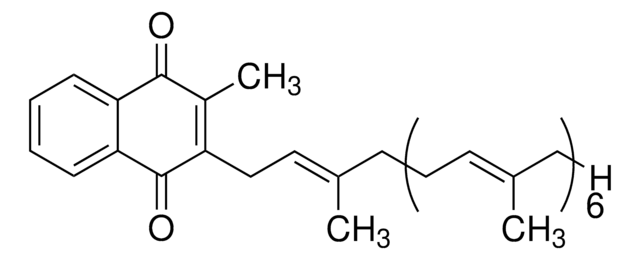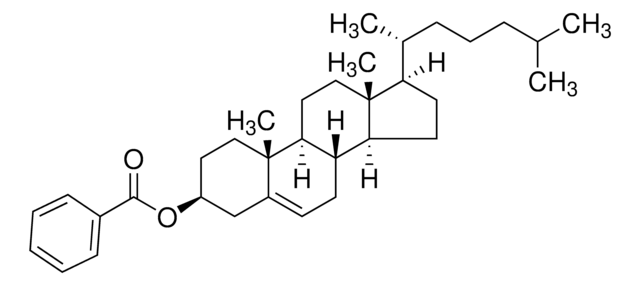1538006
USP
Fitonadion
United States Pharmacopeia (USP) Reference Standard
Synonim(y):
81818-54-4
Zaloguj sięWyświetlanie cen organizacyjnych i kontraktowych
About This Item
Polecane produkty
klasa czystości
pharmaceutical primary standard
rodzina API
phytonadione
producent / nazwa handlowa
USP
Zastosowanie
pharmaceutical (small molecule)
Format
neat
temp. przechowywania
2-8°C
Opis ogólny
This product is provided as delivered and specified by the issuing Pharmacopoeia. All information provided in support of this product, including SDS and any product information leaflets have been developed and issued under the Authority of the issuing Pharmacopoeia.For further information and support please go to the website of the issuing Pharmacopoeia.
Zastosowanie
Wzorzec referencyjny Phytonadione USP, przeznaczony do stosowania w określonych testach jakości i oznaczeniach, jak określono w kompendiach USP. Również do użytku z monografiami USP, takimi jak:
- Phytonadione Tabletki
- Phytonadione Emulsja do wstrzykiwań
- Fitonadion w postaci zawiesiny doustnej
- Preparat witamin rozpuszczalnych w oleju
- Tabletki witamin rozpuszczalnych w oleju
- Menachinon-4
Wzorzec referencyjny Phytonadione USP, przeznaczony do stosowania w określonych testach jakości i oznaczeniach, jak określono w kompendiach USP. Również do użytku z monografiami USP, takimi jak:
- Phytonadione Tabletki
- Phytonadione Emulsja do wstrzykiwań
- Preparat witamin rozpuszczalnych w oleju
- Tabletki z witaminami rozpuszczalnymi w oleju
- Menachinon-4
- Witaminy rozpuszczalne w oleju Roztwór doustny
Komentarz do analizy
Produkty te są przeznaczone wyłącznie do testów i oznaczeń. Nie są one przeznaczone do podawania ludziom lub zwierzętom i nie mogą być stosowane do diagnozowania, leczenia lub wyleczenia jakichkolwiek chorób.
Inne uwagi
Sales restrictions may apply.
Ta strona może zawierać tekst przetłumaczony maszynowo.
produkt powiązany
Numer produktu
Opis
Cennik
Zwroty wskazujące rodzaj zagrożenia
Zwroty wskazujące środki ostrożności
Klasyfikacja zagrożeń
Aquatic Chronic 4
Kod klasy składowania
10 - Combustible liquids
Klasa zagrożenia wodnego (WGK)
WGK 1
Temperatura zapłonu (°F)
Not applicable
Temperatura zapłonu (°C)
Not applicable
Wybierz jedną z najnowszych wersji:
Certyfikaty analizy (CoA)
Lot/Batch Number
It looks like we've run into a problem, but you can still download Certificates of Analysis from our Dokumenty section.
Proszę o kontakt, jeśli potrzebna jest pomoc Obsługa Klienta
Masz już ten produkt?
Dokumenty związane z niedawno zakupionymi produktami zostały zamieszczone w Bibliotece dokumentów.
Klienci oglądali również te produkty
Carmela T M Mascio et al.
Antimicrobial agents and chemotherapy, 58(7), 3976-3982 (2014-05-07)
Surotomycin (CB-183,315) is an orally administered, minimally absorbed, selective bactericidal cyclic lipopeptide in phase 3 development for the treatment of Clostridium difficile-associated diarrhea. The aim of this study was to evaluate the emergence of resistance in C. difficile (ATCC 700057
C Rodriguez et al.
Food microbiology, 42, 166-171 (2014-06-16)
Clostridium difficile has been isolated from food animals and meat, specially ground pork and ground beef. The recovered isolates were closely related to C. difficile human strains, indicating that animals and food are possible transmission routes of human C. difficile infection. The
Ji-Hoi Moon et al.
BMC microbiology, 14, 218-218 (2014-08-26)
Polyphosphate (polyP) has bactericidal activity against a gram-negative periodontopathogen Porphyromonas gingivalis, a black-pigmented gram-negative anaerobic rod. However, current knowledge about the mode of action of polyP against P. gingivalis is incomplete. To elucidate the mechanisms of antibacterial action of polyP
C Rodriguez et al.
Veterinary microbiology, 172(1-2), 309-317 (2014-06-05)
Clostridium difficile has been identified as a significant agent of diarrhoea and enterocolitis in both foals and adult horses. Hospitalization, antibiotic therapy or changes in diet may contribute to the development of C. difficile infection. Horses admitted to a care
Hrisi Bahar Tokman et al.
Clinical laboratory, 60(11), 1879-1886 (2015-02-05)
Anaerobic bacteria play an important role in eye infections; however, there is limited epidemiologic data based on the the role of these bacteria in the etiology of keratitis and endophthalmitis. The aim of this re- search is to determine the
Nasz zespół naukowców ma doświadczenie we wszystkich obszarach badań, w tym w naukach przyrodniczych, materiałoznawstwie, syntezie chemicznej, chromatografii, analityce i wielu innych dziedzinach.
Skontaktuj się z zespołem ds. pomocy technicznej








